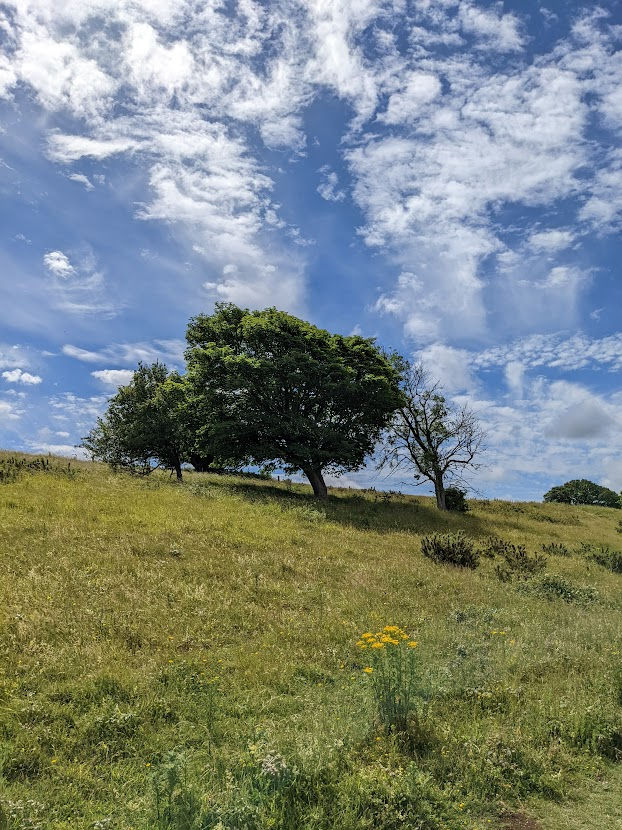The "usual" Birds and Butterflies and well-being. Cissbury Ring. 02.07.22
- Sim Elliott

- Jul 3, 2022
- 3 min read
I did a morning walk to Cissbury Ring on Saturday 02.07.22. I reached Cissbury by train and bus (Brighton to Worthing by train and bus 1 to Findon Valley (to walk up to Cissbury Ring from the main car park). The 1 1 Bus Route & Timetable: Worthing - Midhurst | Stagecoach (stagecoachbus.com) is a two-hourly service, the 23 23 - Crawley - Worthing | Metrobusis also an option and goes every hour

I didn't see anything out of the ordinary; but I enjoyed seeing or hearing the common species of the South Downs (Linnets, Song Thrushes, Skylarks, Kestrels and Meadow Brown, Small Heath, Marbled White, Ringlet, Comma, Red Admiral and Dark Green Fritillary Butterflies. I also saw a Gatekeeper Butterfly for first time this year, and bang on schedule! The average first sighting of Gatekeepers in Sussex is 27th June, according to Blencowe & Hulme, The Butterflied of Sussex, 2017.
Whilst novelty (new species to me), like the Silver-Studded Butterflies of Friday's trip to Iping, brings a lot of joy and excitement, revisiting and appreciating and savouring the "ordinary" pleasures (things I have seen many times) is, I think, also important for well being. We are hard wired psychologically (according to Diener, Lucas, & Scollon, 2006 theory of hedonic adaption) to return to a relatively stable baseline-level of affect (happiness/sadness) following a strong positive or negative experience. e.g. . if you feel moderately sad a lot of the time and you have a positive experience, the positive impact will eventually fade and you'll return to your general sadness. The positive aspect of this phenomenon is that if you are generally happy, and you experience a negative event, people generally return to their generally level of happiness.
However, only about 50% of our level of well-being is considered to be determined by genetic personality factors. There is converging research that volitional behaviours can significantly improve your well-being: savouring past positive experiences and being mindfully aware of present everyday positive experiences (e.g. noting the beauty of a house sparrow) can address the "hedonic treadmill" (the tendency for people who are generally sad and/or anxious to return to sadness/anxiety after a positive experience) by focussing attention on everyday pleasures (e.g. things you find beautiful in nature), and savouring (bringing back to conscious attention) past experiences. For me writing blog or Facebook posts is a way of savouring the pleasures of everyday nature and the pleasure of novel experiences of the natural world.
Noting the beauty of the ordinary is especially important, as there is finite number of things you can see i(and with extinctions of species likely to increase with an unaddressed ecological crisis, there will be a diminishing number of things you can see), and as you get older, statistically you are going to see less things which are new to you!
The photographs are in the chronological order of the walk
Pyramid Orchid

Walking up the Cissbury downs

Dark Green Fritillary on wild marjoram

joined by a Meadow Brown



A male Marbled White on the same marjoram

A Large Skipper on a species of Hawkbit

and it moved to Red Clover



A Song Thrush

Bracket fungus


A Kestrel; I wouldn't have spotted this Kestrel if it hadn't had seen it fly into the tree,

Ringlet


Bumblebee (red-tailed I think)

A Meadow Brown

A Small Heath

Linnet


The view of Brighton

Meadow Brown


Cissbury Ring

The Iron Age hill fort was constructed around 400BC and was used for defence for around 300 years. Cissbury is a univallate fort, that is a hilltop enclosure with a single rampart accompanied by a ditch and a low counterscarp bank. The hill fort encloses around 26 hectares and originally had only two entrances, one at the eastern corner and the other at the southern end.
After 100BC the interior of the fort was used for agriculture with rectangular fields being marked out with earthwork banks and terraces.
There is archaeological evidence of a settlement at Cissbury during the later Roman period. This comprised a group of 11 buildings and two rectangular enclosures situated near the eastern entrance to the fort. The ramparts were heightened at this time possibly in fear of Danish attacks.
The discovery at Cissbury of two successive issues of coinage struck between AD1009 and AD1023 suggests that there was once a mint here.
There is little evidence of activity here during medieval times but many of the local agricultural trackways across the downland are likely to have originated during this period. The story of Cissbury Ring | National Trust

White Bedstraw,, Pyramid Orchid, Heal-All and a Hawkbit; a fairly typical set of flowers on chalk June


Linnets (there were lots!)



Another Dark Green Fritiliary


Small Heath

A Large Skipper



A Gatekeeper



Small Heath

Ringlet

A Red Admiral

The area on the Cissbury Downs (just up from Findon Valley where there were many butterflies)

A very worn Ringlet; possibly a survivor of an attack by a predator (e.g. a bird)

Fresh Ringlet


A Comma

A Comma in flight






Comments